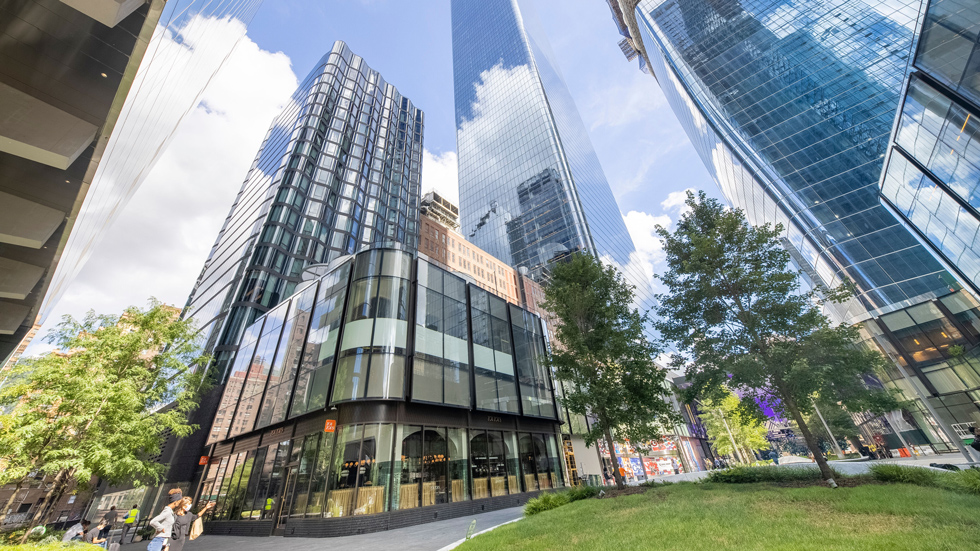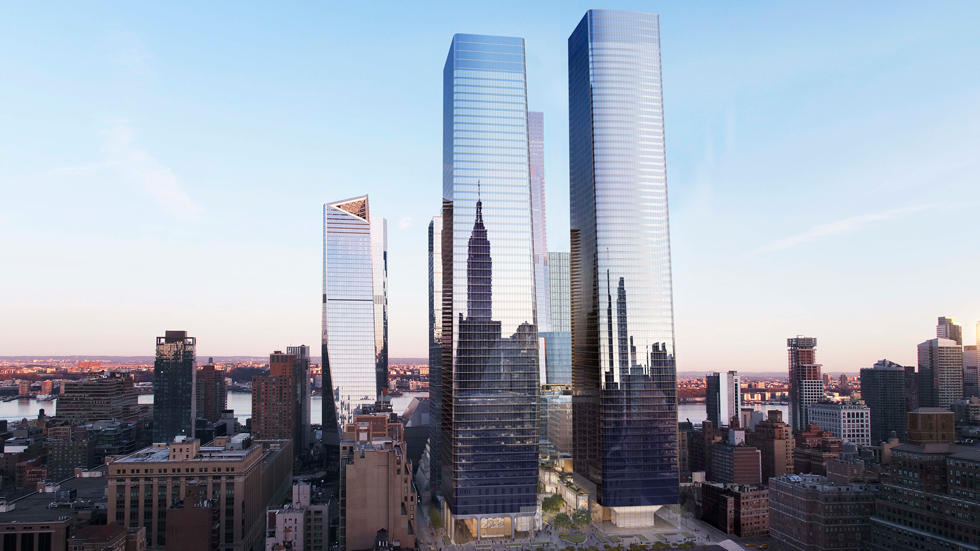Tech-enabled sustainability measures at Brookfield Properties’ One Manhattan West flagship office, which include the use of blockchain for data verification purposes, are taking the 67-story state-of-the-art office tower to a whole new level.
The measures are seen as an important step toward meeting both the company’s broader goal of reaching net zero greenhouse gas emissions across its portfolio by 2050, as well as its tenants own carbon reduction targets.
“One Manhattan West is our most sustainably advanced building, and it will be the first in our New York portfolio to be powered 100% by renewable energy,” says Michael Daschle, senior vice president, operations at Brookfield Properties. The building will be a pilot project with Brookfield Properties directly purchasing power from Brookfield Renewable Partners’ (NYSE: BPE) hydropower plants in upstate New York. [Brookfield Properties and Brookfield Renewable Partners are both majority-owned by parent company Brookfield Asset Management (NYSE: BAM).]
While the purchase of renewable energy was an internal bilateral transaction, Brookfield Renewable is one of the largest producers of hydroelectric, wind, and solar power in the world and any company can contract with them, Daschle points out.
But buying renewable energy is just one part of Brookfield Properties’ forward-thinking sustainability actions. In order to monitor and record their energy use, Brookfield contracted with ClearTrace, an Austin, Texas- based startup that automates tracking energy and emission data in real time.
“There’s lots of hot air out there when it comes to ESG reporting,” says Lincoln Payton, CEO of ClearTrace. “The biggest thing that was missing was quality data to prove what companies were reporting.”
Sophisticated Monitoring
For Brookfield Properties, proving the source of its energy depends on accurate, transparent data.
“We collect data in a very pure, traceable format from all points of energy that a given entity is drawing energy from,” Payton says. In the case of One Manhattan West, he notes, that involves going to each meter, in each turbine, in each tributary of the Hudson River system. “We collect the data of what electricity is being generated in real time.”
ClearTrace also collects real- time data from every meter in One Manhattan West, floor- by-floor and tenant-by-tenant, Payton says, and all the data is digitized and tokenized. “We can track the time, location, and nature of the energy used at every meter,” Payton says.
The ability to monitor energy 24/7 is important, Payton says. “We’re moving from one phase of renewable energy monitoring to the next,” he says. “Lots of companies take energy from the grid that has different components at different times, then they average it on an annual basis. They buy renewable energy credits to offset their carbon emissions.”
While that’s not a bad thing, it’s not the way to move the needle towards carbon-free emissions, Payton says.
The renewable energy credit system is looked at as a form of greenwashing by some people because there isn’t proof that the energy being used is truly renewable, Payton says. He notes that auditable proof of the actual use of green energy is more important.
“We’re using the hydroelectricity by contractual right at the exact same time as it’s being generated, which is why we need the hour-by-hour data from ClearTrace that shows we’re consuming the energy at the exact same time that it’s being generated,” Daschle says.
Technology used to track emissions will become even more important as regulations such as New York City’s Local Law 97, which sets increasingly higher limits on greenhouse gas emissions from buildings beginning in 2024, and proposed Securities and Exchange Commission guidelines are likely to require detailed reporting.
The hourly monitoring is an important component of the sustainability program at One Manhattan West because of the mix of energy in the New York grid at different times of the day.
“Sometimes the energy mix is cleaner than at other times,” Daschle says. “For instance, on a hot afternoon in the summer, the New York electrical grid might bring in other power sources such as natural gas, which is quicker than some other power sources, but also dirtier.”
Brookfield is an early leader in the use of emerging technology to shift its peak use times to a different time of day, Daschle says.
Immutable Data
Monitoring both the use and sources of energy relies on tech innovations. Blockchain provides an excellent technology for self-auditing and managing an extremely large volume of data, Payton says
“Using blockchain means that the data is immutable, and it can’t be replicated,” Paton says. “Each unit of data gets its own NFT (non-fungible token) with the time, location, and nature of energy being produced, bought, transported, and used.”
Layering in blockchain technology provides additional credibility and power to ClearTrace’s data, says Daschle. Blockchain allows anyone to see and audit the data and prevents anyone else from making the same claim to be using renewable energy from the same source at the same time, he explains. “Blockchain provides us with internal verification that we’re carrying out what we promised to do. We can show our tenants the reports so they can verify the data and use if for their own ESG reporting.”
The ability to monitor energy 24/7 is important. We’re moving from one phase of renewable energy monitoring to the next.
Currently, Brookfield and the tenants at One Manhattan West have direct access to the reports generated by ClearTrace. Eventually, as reporting requirements grow, Brookfield will be able to provide reporting organizations with access. “The key is that this is well-organized, granular data that can be reported in any format to anyone from the building owner to the tenant to a regulatory agency,” Payton says. “We can produce load matching reports, renewable energy credit reports, or even just a report on how much of a building’s energy is green.
Stakeholders and Energy Marketing
Tenants at One Manhattan West, which is 98% leased, benefit from Brookfield’s sustainability actions in two ways. The primary benefit is a direct reduction in their carbon emissions, Daschle says.
“Most of our tenants have sustainability goals and many have net zero goals of their own,” he says. “The reports from ClearTrace allow these companies to demonstrate their progress on green goals to their employees and investors. In addition, they’ll be ready for the upcoming SEC ESG reporting requirements.
Payton says more tenants ask their landlords about their carbon footprint today before signing a lease.
“Commercial real estate buildings account for 40% of greenhouse gas emissions around the globe. There’s no question that investors also factor in ESG into their investing decisions, especially in real estate,” Payton says.
Many investors have their own carbon emissions reporting requirements.
Blackstone, which owns 49% of One Manhattan West, is also a market leader in ESG, Daschle notes. “Blackstone has considerable exposure to emissions across their entire portfolio, so their investment at One Manhattan West allows them to zero out their emissions at this particular property.”
One thing Brookfield’s program at One Manhattan West doesn’t do is lower utility bills, however. “This is emerging technology, and it actually adds a premium to utility costs,” Daschle says. “But our tenants are willing to accept the cost because they want to achieve their ESG targets and to get the brand and reputation benefits.”
The cost of electricity and the cost of renewable energy credits has climbed in part because of the high demand for renewable products, Daschle says. He estimates that the dollar cost per megawatt on an hourly basis will be about one-third higher in the next properties in Brookfield’s pipeline compared to the cost at One Manhattan West.
“The cost varies by market and it’s hard to control for, but it’s a risk owners have to face,” Daschle says.
Many real estate companies are actively reducing their carbon footprint for multiple reasons, including their commitment to sustainability, as a sales aid for their buildings and to attract investors, Payton says. “This is where the world is going. We’ve been talking about buying some offsets and making some incremental changes. But now people want details.”
The sustainability program at One Manhattan West has been a draw for the office’s leasing capability, Daschle says. Brookfield plans to introduce the same program at Two Manhattan West and eventually across their entire portfolio. “We’ve purchased hydropower for properties in other markets such as Washington, D.C. and Northern Virginia,” Daschle says. “Our focus is on Brookfield’s net zero greenhouse gas emissions by 2050 commitment, and this is an important part of reaching that goal.

